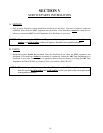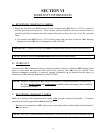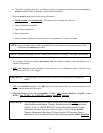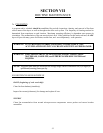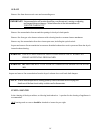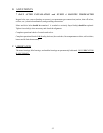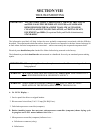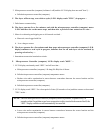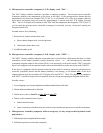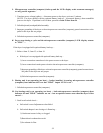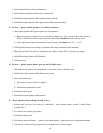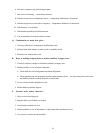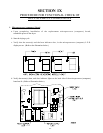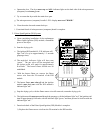
38
G. Microprocessor controller (computer) L.E.D. display reads "Hot" ...
The "Hot" display condition indicates a possible overheating condition. The microprocessor controller
(computer) monitors the temperature in the dryer at all times. If the microprocessor detects that the
temperature in the dryer has exceeded 220º F (104º C), it will disable ALL of the dryer outputs (shut the
dryer down), the buzzer (tone) will sound for approximately 5 seconds, and the L.E.D. display will read
"Hot". The L.E.D. display will continue to read "Hot" until the temperature has dropped to 220º F (104º C)
or lower and the microprocessor controller (computer) is manually reset by closing and opening the
Program Switch (PS).
Possible reasons for overheating ...
1. Restriction in location exhaust duct work ...
a. Dryer exhaust damper stuck in closed position.
b. Undersized exhaust duct work.
2. Insufficient make-up air.
H. Microprocessor controller (computer) L.E.D. display reads "SEFL" ...
The "SEFL" display condition indicates a rotational sensor circuit failure which means that there is a fault
somewhere in the basket (tumbler) rotation detection circuit ... or ... the microprocessor controller
(computer) program related to this circuit (PL01) is set incorrectly in the active mode ("SEn") where the
dryer is not equipped with the optional rotation sensor and should be set in the non-active mode ("nSEN").
If the dryer is equipped with the optional rotational sensor and for whatever reason the microprocessor
controller (computer) detects that the basket (tumbler) is not turning, it will disable
ALL of the dryer
outputs (shut the dryer down), and the L.E.D. display will read "SEFL". The L.E.D. display will continue to
read "SEFL" until the microprocessor is manually reset by closing and opening the Program Switch (PS).
Possible causes...
1. Loose/slipping (out of proper adjustment) basket/tumbler and/or idler belt.
2. Broken basket/tumbler and/or idler belt.
3. Failed motor (refer to Item B on page 36 and page 37).
4. Failure in the rotational sensor circuit ...
a. Failed rotational sensor.
b. Loose connection or break between the rotation sensor and the microprocessor controller (computer).
I. Microprocessor controller (computer) will not accept any, or only accept certain keyboard (touch
pad) entries ...
1. Failed keyboard (touchpad) label assembly.
2. Failed microprocessor controller (computer).




